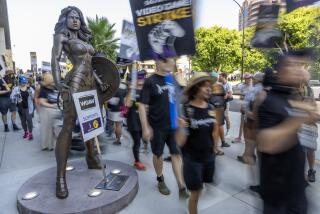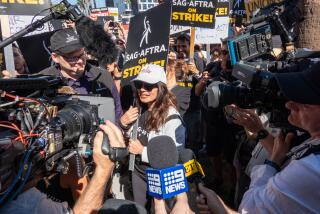Actors Strike Over Fee System for Commercials
- Share via
The actors who pitch everything from soap to soft drinks on television and radio, often seen as the less glamorous members of the entertainment industry, went on strike Monday against the advertising industry.
The strike by members of the Screen Actors Guild and the American Federation of Television and Radio Artists, the first work stoppage in Hollywood in 12 years, is not expected to be settled easily or quickly. It may signal further Hollywood labor unrest.
At the heart of the strike is a desire by actors to end the flat-fee system for ads that air on cable television. The union is seeking payments for the actors whenever an ad airs on cable, just as they are paid residuals whenever a network commercial runs. The actors also want to address the fledging issue of how they will be paid when ads run on the Internet.
Ad industry negotiators counter that the splintering of TV audiences that has occurred with the proliferation of new channels means ads have to run more often to reach the same number of people, even on the major networks. So the old formula is unworkable, they argue, and instead they want actors to accept a flat fee for their work.
SAG estimates that 40,000 of its 97,000 members have appeared in commercials, earning a total of about $600 million annually.
Although some celebrities and sports stars enjoy lucrative endorsement contracts--actress Lindsay Wagner, for example, receives $600,000 to $700,000 as the spokeswoman for Southern California Ford dealers--the union argues that the vast majority of commercial actors barely make a living, or have to hold down other jobs to make ends meet.
Actor Gary Epp, who has appeared in commercials for such products as Thomas English Muffins and Motrin, said he makes between $5,000 and $8,000 per commercial, depending on how often the spots air.
“In a good year, I get four or five commercials, which is more than the average actor does. It probably pays more to make the French fries at McDonald’s than it does to make the McDonald’s commercials,” he said.
Late Monday, actors scored their first victory when they got a Nike commercial featuring golfer Tiger Woods--a SAG member--postponed indefinitely. Actors had threatened to picket the Florida country club where the commercial was to have been filmed.
Actors marked the start of the strike Monday with marches in Los Angeles, Chicago, New York and San Francisco. In Los Angeles, about 1,000 people--including such well-known actors as Elliott Gould and Richard Crenna--marched down Wilshire Boulevard, chanting “Hey, hey, ho ho, corporate greed has got to go,” stopping along the way to picket outside various advertising agency offices.
“This industry is called show business, and it’s time advertisers learned how little business they can generate when SAG and AFTRA members don’t show up for work,” said SAG President William Daniels.
The two sides last met April 14. A federal mediator failed to resolve the disagreements.
“There is a huge gulf here,” said Century City lawyer Richard E. Posell, who represents ad production companies. He predicts a strike of at least two months. “I have a client who decided to get his knee surgery out of the way now.”
Despite the strike, Ira Shepard, labor counsel for the committee that is representing two ad industry associations--the Assn. of National Advertisers and the American Assn. of Advertising Agencies--said commercials will continue to be produced with nonunion talent or union members who cross the picket lines. “From our vantage point, we’re continuing to produce commercials using whatever talent will work,” Shepard said.
The last entertainment industry labor action was in 1988, when actors went on strike for about three weeks. That was the same year of Hollywood’s most devastating strike to date, an action by the Writers Guild of America that nearly destroyed the television season that year and cost the industry an estimated $500 million.
While Monday’s action is limited to actors working in commercials, it is a sign of more labor troubles ahead for Hollywood.
There is a growing discontent among the entertainment industry’s rank and file workers, who say they are being denied their share of the riches that have come with the explosion in the entertainment business. Specifically, they want a bigger piece of the profits in cable television, Spanish-language channels and other growing TV markets.
These same issues will be front and center next year when studios and networks negotiate new contracts with actors and writers.
He argues that the ad industry’s latest offer is generous. Under it, he said, an actor in a commercial would make a flat payment of $2,575 if a commercial aired at least once on a network, and an additional $1,627 if it aired once on cable.
“You name me an industry where the scale is $4,200 for one day’s work,” Shepard said. “And it isn’t even that rigorous.”
But actors counter that such numbers are misleading. Stretched over the life of the commercial, they argue, the amounts come to a few dollars a day. The statistics, they say, also don’t take into account that actors get few commercial opportunities and have to pick up other costs themselves, from paying agents to having their own publicity photos taken.
“People think that we make crazy amounts of money. The problem is that for every hundred auditions you do, you get one job,” said Giselle Loren, who has recently appeared in English- and Spanish-language ads for Foster Farms, Ralston Purina and BP Amoco.
SAG Offers Agencies Temporary Waivers
As only the shooting of new commercials is affected, the impact won’t be felt for a while because any completed ads can be run. In addition, many commercials were put on a fast track in anticipation of the strike.
Still, SAG immediately started asking actors and sports stars who are SAG members to scuttle their commercials this week unless the ad agencies and companies agree to pay according to SAG’s latest proposal.
SAG officials said that the SAG members can still act in commercials and remain in good standing if the ad agency agrees.
“All we’re saying is that during the strike, while we are at loggerheads here, all the advertising agencies have to do is sign an interim agreement,” said actor and SAG activist Gould.
Shepard said that none of the 300 agencies and 150 large advertisers he represents has broken rank yet and signed a temporary waiver with SAG.
One possibility for circumventing the strike is to shoot commercials overseas, but SAG has been lining up support from unions in Canada and Europe, hoping to prevent ad productions from moving there.
Most affected will be companies trying to launch a new product or campaign because they won’t have access to 135,000 SAG and AFTRA members affected by the negotiations unless the members cross the picket lines.
“You could be dead in the water if you have a new product. All of a sudden you have a product on the shelf, but don’t have any new spots to pitch it,” said Ashley Postelwaite, executive producer at Renegade Animation, which makes commercials for Cheetos snacks, among other things.
Also hurt could be the Hollywood economy. Commercial production grew into an increasingly important part of the economy during the 1990s. One of five permits issued to shoot in the streets of Los Angeles County are for commercial productions.
“Not making commercials and people not getting their paychecks will make a dent if it’s a long strike. We don’t have a dollar number for the industry, but we know in a localized sense it’s important,” said Rajeev Dhawan, director of the UCLA Anderson School’s economic forecasting project.
More to Read
The biggest entertainment stories
Get our big stories about Hollywood, film, television, music, arts, culture and more right in your inbox as soon as they publish.
You may occasionally receive promotional content from the Los Angeles Times.










